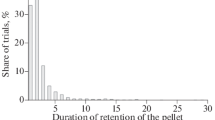Summary
Hydra shows three types of feeding responses to chemostimulants. They are ‘writhing’ of tentacles, ‘ball-formation’ of tentacles and ‘mouth-opening’.
The chemostimulants can be divided into 3 classes on the basis of specificities of the responses they elicit. The first class includes tripeptides glutathione (reduced form) and S-methyl-glutathione. These chemicals evoke all three types of responses. The second class contains dipeptidesγ-glutamylcysteine,γ-glutamyl-S-methyl-cysteine andγ-glutamyl-α-amino butyrate and amino acidl-arginine. These chemicals evoke mouth-opening and writhing of tentacles, but not ball-formation. The third group contains amino acidsl-leucine,l-tryptophan andl-lysine. These chemicals evoke writhing and ball-formation of tentacles but not moutho-pening. These observations indicate the existence of different specificities of the three feeding responses inHydra to chemostimulants.
In addition to evoking tentacular movements, the amino acids of the third group also have the capacity to competitively inhibit the mouthopening response induced by S-methyl-glutathione. Evidence exists which suggests thatHydra has different receptors for those amino acids which inhibit mouth-opening and for those which evoke the tentacular movements.
Tentacles cut off animals show the typical writhing response to S-methyl-glutathione. The sensitivity of this response is similar to the response of tentacles on intact animals. This suggests that the entire set of receptor-effector system for writhing response is present in individual tentacles. The present results suggest that each feeding response is executed by a different receptor-effector system.
Similar content being viewed by others
Abbreviations
- GSH :
-
reduced glutathione
- GSM :
-
S-methyl-glutathione
- γ-Glu-CysH :
-
γ-glutamyl-cysteine
- γ-Glu-CysMe :
-
γ-glutamyl-S-methyl-cysteine
- γ-Glu-Abu :
-
γ-glutamyl-α-aminobutyr-ate
References
Award W Jr, Wilcox PE (1964) Conversion of cysteine to serine in reduced glutathione. Biochem Biophys Res Commun 17:709–715
Grimmelikhuijzen CJP, Balfe A, Emson PC, Powell D, Sundler F (1981) Substance P-like immunoreactivity in the nervous system ofHydra. Histochemistry 71:325–333
Hanai K (1981) A new, quantitative analysis of the feeding response inHydra japonica: Stimulative effects of amino acids in addition to reduced glutathione. J Comp Physiol 144:503–508
Hirakawa Y, Kijima H (1980) Behavioral analysis of glutathione receptor ofHydra: I. Mouth-opening threshold, inhibition constant and their temperature dependence. J Comp Physiol 137:73–81
Kinnamon JC, Westfall JA (1981) A three dimensional serial reconstruction of neural distributions in the hypostome of aHydra. J Morphol 168:321–329
Koizumi O, Kijima H (1980) Specific S-methylglutathione incorporation into a nematocyst-rich fraction of hydra. Biochim Biophys Acta 629:338–348
Koizumi O, Maeda N (1981) Rise of feeding threshold in satiatedHydra. J Comp Physiol 142:75–80
Lenhoff HM (1961) Activation of the feeding reflex inHydra littoralis I. Roles played by reduced glutathione and quantitative assay of the feeding reflex. J Gen Physiol 45:331–344
Lenhoff HM, Bovaird J (1961) Action of glutamic acid and glutathione analogues on theHydra glutathione-receptor. Nature 189:486–487
Lenhoff HM, Brown RD (1970) Mass culture of hydra: An improved method and its application to other aquatic invertebrates. Lab Anim 4:139–154
Lindstedt KJ (1971) Biphasic feeding response in a sea anemone: control by asparagine and glutathione. Science 173:333–334
Loomis WF (1955) Glutathione control of the specific feeding reaction of hydra. Ann NY Acad Sci USA 62:209–228
Rushforth NB (1973) Behavior. In: Burnett AL (ed) Biology ofHydra. Academic Press, New York London, pp 3–41
Smith S, Oshida J, Bode H (1974) Inhibition of nematocyst discharge in hydra fed to repletion. Biol Bull 147:186–202
Author information
Authors and Affiliations
Rights and permissions
About this article
Cite this article
Koizumi, O., Haraguchi, Y. & Ohuchida, A. Reaction chain in feeding behavior ofHydra: Different specificities of three feeding responses. J. Comp. Physiol. 150, 99–105 (1983). https://doi.org/10.1007/BF00605293
Accepted:
Issue Date:
DOI: https://doi.org/10.1007/BF00605293




